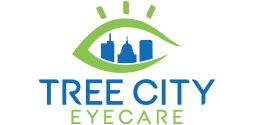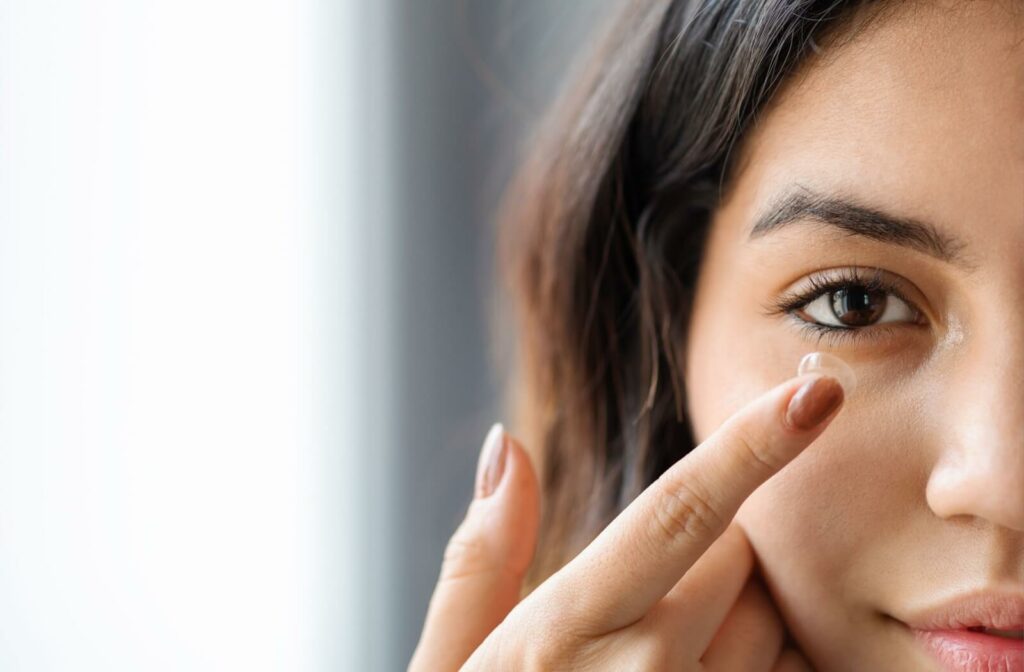Contact lenses are a popular alternative to eyeglasses, offering convenience, a wider field of view, and in some cases better vision correction. However, not all contact lenses are created equal.
With so many contact lens types available, a fitting helps your optometrist determine the most suitable contact lens for your lifestyle and visual needs.
During a contact lens fitting individuals will have:
- Measurements taken of their eyes
- A contact lens trial period
- A finalized prescription
Understanding Contact Lenses
Contact lenses correct vision by directly altering the way light enters the eye. When light rays pass through a contact lens, it’s refracted to focus properly on the retina. In an eye with refractive errors, adjusting how light lands directly on the retina provides clear vision.
Understanding the different types of lenses available can help you choose the best option for your eyes and vision needs.
Different Types of Contact Lenses
Several types of contact lenses are available, each designed to cater to specific vision needs and lifestyle preferences. We’ll explore some of the most common options that we provide.
Soft Contact Lenses
Soft contact lenses are made from flexible, water-absorbing materials. They conform to the shape of your eye, making them comfortable for most people, and are one of the most popular types of contacts.
- Suitability: Ideal for those with active lifestyles or dry eyes.
- Vision Correction: Available in single vision and multifocal prescriptions.
- Advantages: Comfortable, easy to adapt to, and available in daily, bi-weekly, and monthly disposables.
Rigid Gas-Permeable Contact Lenses
Also known as RGP or hard contact lenses, these are made from durable materials, making them harder and less flexible than soft contact lenses. These have a rigid structure that maintains their shape, which helps provide sharp vision and allows for a high level of oxygen flow to the eye.
They are often used by individuals who need precise vision correction, and while they may take a little longer to adjust to than soft lenses, many wearers appreciate the crisp clarity they offer.
- Suitability: Great option for those with irregular corneas or specific eye conditions like keratoconus.
- Vision Correction: Available in both single vision and multifocal prescriptions.
- Advantages: Provide crisp, clear vision and are more durable than soft lenses.
Ortho-k lenses are a type of RGP lens, designed for overnight wear and provide temporary vision correction by reshaping the cornea. They’re a great option for myopia control and a substitute for refractive surgeries.
Scleral Contact Lenses
Scleral lenses are larger in diameter and rest on the sclera rather than the cornea like traditional lenses. They’re thicker than traditional contact lenses and create a cushioning effect by holding a layer of saline solution on the eye, making them particularly useful for individuals with certain eye conditions or sensitivity.
Many find them comfortable, and they offer a unique approach to vision correction for those who struggle with standard lenses.
- Suitability: Ideal for people with severe dry eyes or irregular corneas.
- Vision Correction: Customizable for various vision correction needs.
- Advantages: Extremely comfortable and provide great stability.
The type of contact lens you choose will depend on various factors including your vision needs, lifestyle, and eye health, which will all be discussed during your contact lens fitting.

What is a Contact Lens Fitting?
Regardless of how long you’ve been wearing contacts, a fitting helps your optometrist find the most suitable lenses for your eyes. It confirms that the lenses align with the unique shape and size of your eyes, providing comfort, and good visual clarity, and minimizing the risk of complications.
This procedure includes measuring the curvature of the cornea, assessing the size of the eye, and discussing specific vision needs and lifestyle factors. The goal is to find a lens that provides a good fit, comfort, and vision correction.
Plus, the shape and health of your eyes can change over time due to factors such as age, health, or changes in prescription. Regular fittings help confirm your eyes are healthy enough to continue wearing contact lenses.
What to Expect During a Contact Lens Fitting
For those who wear soft, RGP, or ortho-k lenses, the fitting process is relatively similar. During the fitting, your optometrist will:
- Measure Your Eyes: Using tools like a corneal topographer to map the surface of your eye. This technology confirms the lenses conform perfectly to your eyes, enhancing comfort and vision.
- Trial Period: You’ll wear trial lenses to assess comfort and vision. Adjustments may be made before finalizing your prescription.
- Final Prescription: Once the ideal fit and prescription are determined, your final lenses will be ordered.
Because of the non-traditional shape and structure of the lens, individuals who are scleral contact lens wearers will undergo the same process, using a different corneal topographer.
Scleral Contact Lens Fitting
The Eaglet-Eye Scleral Profilometer plays a key role in fitting scleral contact lenses.
This advanced technology captures a three-dimensional profile of the eye’s surface, providing detailed data that confirms an accurate fit for scleral lenses. By using this device, optometrists can obtain precise measurements of the sclera and cornea, providing a customized lens that matches the unique features of each patient’s eye.
The benefits of using the Eaglet-Eye Scleral Profilometer during the fitting include:
- Enhanced Comfort: Patients experience increased comfort during lens wear, reducing the likelihood of irritation or shifting because of the fit based on precise measurements.
- Improved Visual Acuity: Detailed mapping allows for ideal lens positioning, which can significantly enhance clarity of vision, especially for those with irregular corneas.
- Reduced Risk of Complications: Accurate fitting minimizes potential complications associated with poorly fitted lenses, such as corneal hypoxia or discomfort.
- Time Efficient: The accuracy decreases the time spent on multiple fittings, providing quicker access to suitable lenses.
Schedule a Visit
Finding the ideal contact lens fit is necessary for comfort and good vision. Whether you’re new to contact lenses or have been wearing them for years, a professional fitting can make a world of difference.
Connect with our team at Tree City Eyecare to schedule an appointment for your contact lens fitting!


